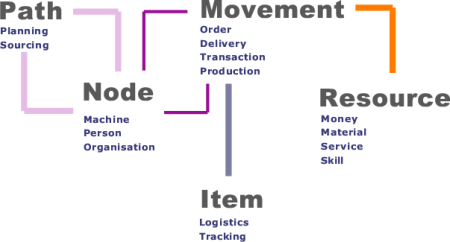ERP5
ERP5 provides a consistent and unified solution for governments and public administrations looking for a proven, global and scalable open source framework to cover their application needs. ERP5 covers finance, human resources, asset management, inventory, document management and knowledge management. It also implements a unique and innovative approach for eGovement: "Digital Paper". ERP5 has been implemented successfully by states, public agencies and extraterritorial organisations worldwide.
Contents
Unified Business Model (UBM)
What is Unified Business Model?
Unified Business Model (aka UBM) is an abstract business model which makes ERP5 fantastic. Jean-Paul Smets, the author of ERP5, innovated this idea when creating the first version of ERP5, and the model has been applied to all applications built on the top of ERP5.
Since this model was so essential and valuable, the name of ERP5 got named after the UBM, namely, ERP which is built only with 5 concepts described by the Unified Business Model, thus it is called ERP5.
What are the 5 concepts in Unified Business Model?
UBM consists of 5 concepts, that is, Node, Resource, Movement, Item, and Path.
Node represents a node which is involved with business processes, such as a person, an organisation, a warehouse, a bank account and so on. It is analogous to the concept of node in graph theory, mathematically speaking.
Resource is a tangible or intangible which is transferred between Nodes in business processes. For example, a Resource can be a product, a raw material, a service, cash, and so on.
Movement specifies a move between Nodes with a Resource associated. It is similar to the concept of directed edge in graph theory. It includes ordering, deliveries, accounting transactions, payments, manufacturing processes, and so on.
Item enables the traceability of Resources. This is similar to the concept of instance in object-oriented programming, when Resource is regarded as class. Item can represent a barcode, an RFID, a subscription, or, a ticket, for example.
Path shows a possible Movement which is useful to define trade conditions, supply conditions, payroll models, etc., and provides support for logistics, supply chains, pricing, and so on.
How is the Unified Business Model used in ERP5?
The UBM is completely integrated into the implementation of ERP5. All documents in ERP5 are designed, according to the model, and all tools and utilities in ERP5 make use of the model to unify the implementation among various business activities, such as trade, manufacturing, customer relationship management, accounting, and project management.
This has made it feasible to rapidly develop new applications on ERP5, and lower the maintenance cost at the same time, because all data shares the same design architecture, thus the amount of code is dramatically reduced.








